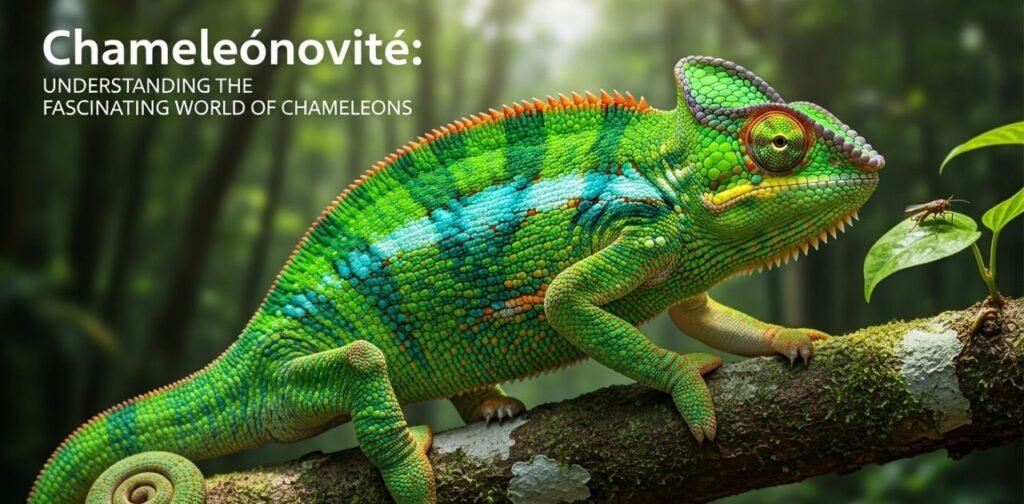Introduction
The word Chameleónovité refers to the family of reptiles known as chameleons (Chamaeleonidae). These unique creatures have long fascinated scientists, nature enthusiasts, and casual observers because of their extraordinary ability to change colors, move their eyes independently, and adapt seamlessly to their environments. With over 200 recognized species spread across Africa, Madagascar, Europe, and parts of Asia, chameleons represent one of the most diverse and specialized reptile families in the animal kingdom.
What makes chameleons so fascinating is not just their exotic appearance, but the scientific marvels hidden in their biology. Their zygodactylous feet, projectile tongues, and skin nanocrystals all demonstrate millions of years of evolutionary adaptation. The family Chameleónovité is, therefore, a living laboratory of survival strategies that blend camouflage, communication, and predation into one.
In this article, we’ll dive deep into the world of Chameleónovité—covering their origins, characteristics, habitats, behaviors, and their crucial role in biodiversity.
The Biological and Evolutionary Background of Chameleónovité
The family Chameleónovité (Chamaeleonidae) belongs to the order Squamata, which also includes lizards and snakes. Their evolution highlights fascinating adaptations that distinguish them from other reptiles.
Origins and Distribution
- Chameleons are believed to have originated in Africa, with Madagascar being home to the highest diversity of species.
- They later spread into Europe, the Middle East, and parts of South Asia.
- Fossil records suggest their lineage dates back nearly 60 million years, making them one of the oldest specialized reptile families.
Distinguishing Traits
- Color Change: Contrary to popular belief, chameleons don’t change colors just for camouflage. They also use it for thermoregulation and communication.
- Independently Moving Eyes: Each eye rotates 180° in different directions, giving them a full panoramic view.
- Projectile Tongue: Their elastic tongues can extend up to twice the length of their bodies to capture prey with lightning speed.
- Gripping Feet and Prehensile Tail: These allow them to climb trees and shrubs with unmatched agility.
Evolutionary Significance
Chameleónovité’s adaptations show how species evolve to dominate ecological niches. They’re arboreal hunters, finely tuned to tropical and subtropical ecosystems where stealth and precision ensure survival.
Habitats and Environmental Adaptations
The habitat of Chameleónovité plays a crucial role in their survival and diversity. Unlike reptiles that thrive in deserts or wetlands, chameleons are primarily arboreal (tree-dwelling), though some species adapt to bushlands and grasslands.
Geographic Spread
- Madagascar: Nearly half of all chameleon species live here, with some endemic species like the Panther Chameleon (Furcifer pardalis).
- Africa: Central and East Africa are home to iconic species like the Jackson’s Chameleon (Trioceros jacksonii).
- Europe and Asia: A few species like the Common Chameleon (Chamaeleo chamaeleon) inhabit Mediterranean regions.
Environmental Adaptations
- Camouflage Mastery: Their ability to shift colors according to environment, mood, and temperature allows them to thrive in diverse landscapes.
- Thermal Regulation: Darker shades absorb heat in cooler mornings, while lighter shades reflect sunlight in hotter conditions.
- Dietary Adaptability: Insects form the bulk of their diet, but some species consume vegetation when insect populations decline.
Challenges in Habitat
Deforestation, climate change, and the exotic pet trade threaten many species of Chameleónovité. As arboreal creatures, their survival depends heavily on forest cover and stable ecosystems.
Behavior and Communication in Chameleónovité
Chameleons are not just biologically unique; their behaviors make them even more remarkable.
Color as Language
- Mating Displays: Males show bright colors to attract females or ward off rivals.
- Aggression Signals: Darker or more vivid patterns often indicate dominance or territorial defense.
- Stress and Fear: When threatened, chameleons adopt colors that signal distress or help them blend into surroundings.
Hunting and Feeding
- Their tongues strike prey in less than 0.07 seconds, making them one of the fastest predators in the reptile world relative to size.
- They primarily eat crickets, grasshoppers, flies, and occasionally smaller reptiles.
Social Behavior
- Chameleons are solitary creatures, meeting others mainly for mating purposes.
- They are territorial, with males often engaging in visual “color battles” rather than physical fights.
Their communication system through colors, postures, and slow movements makes them one of the most visually expressive reptile families.
Conservation of Chameleónovité
Like many wildlife groups, chameleons face growing threats from human activity.
Major Threats
- Deforestation – Loss of forest habitats endangers species that rely exclusively on arboreal environments.
- Climate Change – Alters their habitats, affecting breeding and prey availability.
- Illegal Wildlife Trade – Many chameleon species are captured and sold as exotic pets.
- Urbanization – Expanding human settlements fragment their ecosystems.
Conservation Efforts
- Protected Areas: Madagascar and African reserves safeguard critical habitats.
- CITES Regulations: Many chameleon species are protected under the Convention on International Trade in Endangered Species.
- Captive Breeding Programs: Help maintain populations and reduce wild captures.
- Awareness Campaigns: Educating communities on the ecological importance of chameleons.
The future of Chameleónovité depends on balancing human development with biodiversity preservation.
FAQs About Chameleónovité
Q1. What does Chameleónovité mean?
It refers to the reptile family Chamaeleonidae, commonly known as chameleons.
Q2. How many species of Chameleónovité exist?
There are over 200 recognized species, with new species still being discovered.
Q3. Do all chameleons change color?
Yes, but the degree varies. Some species display dramatic color shifts, while others show subtle changes.
Q4. Where are chameleons most commonly found?
They are most diverse in Madagascar and Africa, with smaller populations in Europe and Asia.
Q5. What do chameleons eat?
They primarily eat insects, though larger species may eat small reptiles or birds.
Q6. Are chameleons endangered?
Many species face threats from habitat loss and illegal trade, though conservation efforts are ongoing.
Q7. Can chameleons be kept as pets?
Yes, but they require specialized care, and buying from ethical, legal sources is crucial to avoid harming wild populations.
Conclusion
The family Chameleónovité represents one of the most fascinating branches of the reptile world. With their vibrant colors, incredible hunting techniques, and unique adaptations, chameleons embody the power of evolution at work. They are not just exotic creatures; they are symbols of biodiversity, ecological balance, and natural artistry.
However, their survival is under pressure due to habitat destruction, climate change, and human exploitation. Protecting Chameleónovité means more than just saving a family of reptiles—it means preserving the delicate balance of ecosystems where they play an important role as insect regulators and as part of the food chain.
Looking into the future, we must ensure that conservation strategies, awareness campaigns, and sustainable practices help protect these magnificent creatures. By valuing the science, culture, and wonder of Chameleónovité, we safeguard not only their future but also the richness of life on our planet.



